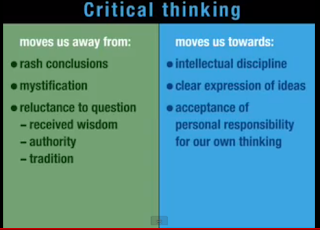 |
| Why We Care About Critical Thinking |
In my advanced undergraduate class, I can usually classify my students into 3 categories: the non-questioners, the trivial questioners, and the rare critical thinking questioner. By the end of my course, I want my students to find themselves generally in this latter category.
In the first category, the non-questioner, we find the shy students who are uncomfortable speaking up. This silence could be the result of inherent shyness, poor classroom experiences, or even cultural issues. In fact, this point of 'cultural issues' reminds me that it is important for me to remember that women and minorities are frequently ignored or blatantly omitted from discussions. In my experience, there are as many if not more women promoting the discussions in my course as men. Regardless, I try to address the issue of cultural differences early by calling on women and minorities during our
 |
| The Shy Student |
 |
| Were you there? Only applies to science not the New Testament. |
So how do I encourage questions/comments of these 2nd category students without pushing them into the 1st category? What I have found works is to mimic Socrates, I ask questions. For example...
I am concerned that the study only used female mice and I wonder what the data would be if male mice were used?
Why do you think this might make a difference? I agree that there are important differences between females and males, I'm wondering how you think these differences apply to this study?
Well there could be differences due to hormones or something...
That's a great point, because that is clearly the case in certain instances like Paracoccidiodes infections. Is there anything in this system that makes you think there is would be a sex-based difference?
.....
Ok that's a good point at face value, but maybe needs further consideration, did anyone have additional issues with this study?The point is to encourage/require the students to have a scientific justification for their concerns, questions, critiques. This, in my opinion, is the most difficult thing the students can learn and that I can teach. The point is that I need to teach the students how to question the studies, but also to question their own questions/concerns. But, I want to emphasize that it is ok to be wrong! We talk about well conducted studies that have generally solid conclusions and identify potential concerns. These concerns may not change the overall conclusions, but do raise concerns with sub-conclusions that may not be valid. In fact, the introductory paper we are discussing is the one I railed on previously. We will also be considering the press release. This is a change from the last couple of years when we discussed a well written, described, and assessed paper. I'm interested in how this approach works.
 |
| Own this book!!! |
Finally, we come to the third category: the critical thinker questioners. For these students, I can only refine their skills, improve their writing, and expose them to new and interesting areas. Almost uniformly, these students have research experience and likely significant experience. However, these students almost certainly have holes based on the areas they have been exposed to. These students know the potential issues in the area they are familiar with, but lack the similar approach/mindset in the areas they are not familiar with. This is one of the reasons it is essential for scientists to read well outside their fields. Breadth of knowledge promotes a better assessment for how your studies fit into the broader world of science. This increases the impact of your research not only from the study in question, but also in the questions you ask in the first place.
FYI. While I have categorized student comments/questions into 3 groups, no one student (nor the instructor) fits into a given group. Furthermore, I love my course because I learn so much from the students, even those that tend to cluster in a specific category. The lessons I learn may vary, but I learn important concepts, holes, insights from all three groups. I thank the students from previous years for helping me develop these insights and to improve my courses.
















No comments:
Post a Comment